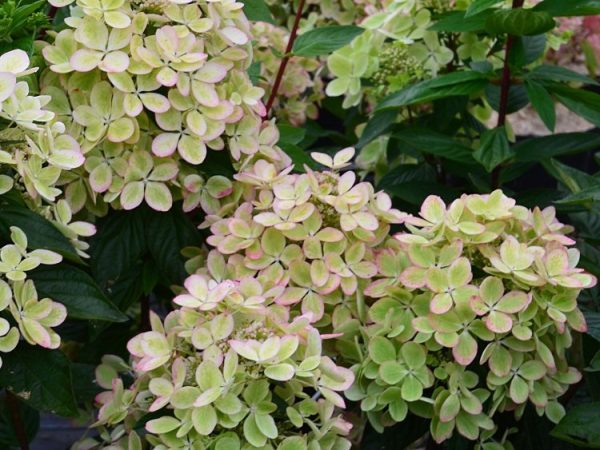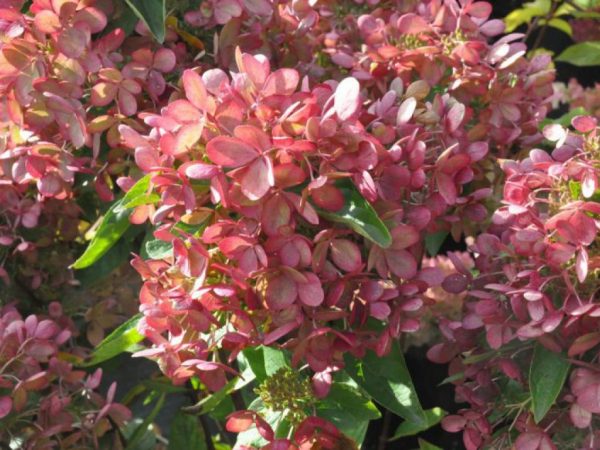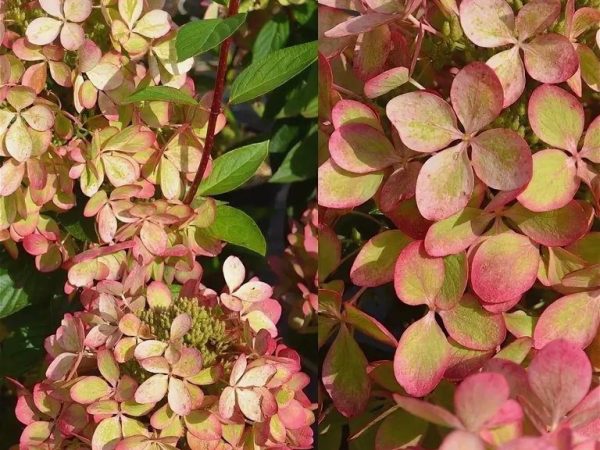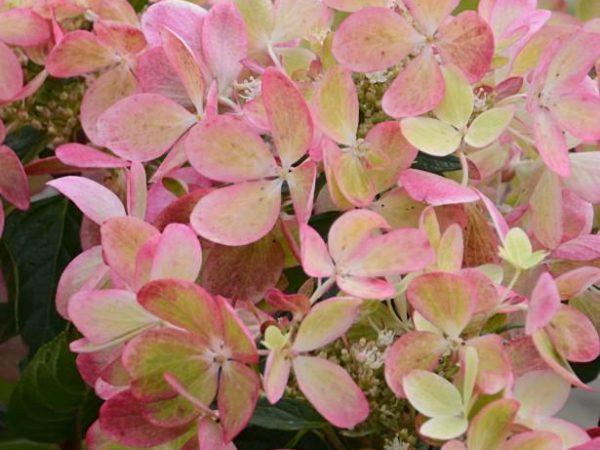Hydrangea paniculata Pastel Green - features of cultivation
Panicle hydrangea Pastel Green is just appearing on the domestic market. This is a new variety from the renowned French breeder Jean Reno, patented in 2016. It features chameleon flowers that change colors up to 7 times during the season. The plant was awarded a silver medal at the international exhibition Plantarium-2016.

Hydrangea pastel green photo and description
Description of the variety
Pastel Green is a low-growing variety of the panicle hydrangea subspecies from the Rencolor series. The international name is Hydrangea paniculata Pastelgreen Rencolor. At the moment, the oldest 7-year-old bush has reached a height of 120 cm and a width of 100 cm.According to forecasts, its growth will not exceed 150 cm.
The bush is erect, slender, not prone to drooping. The branches are thin, but strong, reddish-brown in color. Leaves typical of hydrangeas: egg-shaped, pointed, opposite, with well-pronounced veins. The color is deep dark green, lightening towards the top. In autumn, the bottom turns yellow and red.
The main advantage of Pastelgreen Rencolor is its color-changing flowers. Moreover, there is no clear division in time, therefore they are called chameleons. The plant produces many peduncles, but they are compact in size - 15-20 cm long. The brush is not dense, does not have a conical shape characteristic of paniculata. Closer to spherical.
But the flowers themselves are larger in size than usual. Sterile ones take 65% of the volume, fertile ones - 35%. On each grow 4 (occasionally 5) widely spaced smooth petals.
The flowering season is from mid-July to early October. In the first phase of flowering, they are white-green, then unpredictably change color to pastel-cream, pistachio with a reddish border, light green, pale pink. Moreover, on the same bush and even inflorescences, flowers of different color palette grow side by side. By the end of flowering, pink-raspberry and wine shades prevail.
Landing features
Hydrangea paniculata is a big lover of acidic soils. If the site is alkaline or neutral, it is advisable to acidify the planting site.
It is important that the soil is slightly damp, with a clay base that retains water and a fertile top layer rich in humus.
Timing
Hydrangea in the middle lane can be planted from mid-spring to mid-autumn, but no later than October - a month before frost. The most favorable period is considered to be from mid-April to mid-June.
The soil is already warmed up enough, while there is still a lot of moisture in it. Dry and hot July is not the best time to experiment.
Seat selection
An ideal place would be a site illuminated in the morning and afternoon, and in the sultry noon, remaining in the shade of buildings or bushes. If there is a difficult choice between full shade or open sun, the sun is preferred.

Hydrangea pastel green description
From excess sun, you can build a protection and additionally water the plant. In the shade, the intensity of flowering is less, the flowers are smaller, and the season is shorter. In doing so, the green mass will flourish.
Preparation consists in examining neighboring plants for diseases and pests. Obligatory weeding and mowing of the lawn in the root zone. If there are a bunch of branches, boards, old film nearby, they must be removed - slugs can hide under shelters.
Preparation of planting material
For planting, choose healthy rooted cuttings or seedlings without a hint of rust, mold and spots on the leaves. A uniform, juicy green color of foliage and dense, not sluggish young shoots will tell a lot about health.
If specimens with an open root system are planted, the roots are slightly trimmed and kept for a couple of hours in a light solution of potassium permanganate or fungicides to prevent the appearance of root rot during the adaptation period in a new place.
Landing technology
Considering the small size of Pastelgreen Rencolor, they dig a hole of 40x40x40 cm. It is possible 10-15 cm deeper. Be sure to lay drainage - this is the most important component for plant health.
The stores sell special fillers based on expanded clay, vermiculite, clay, and more. But the materials at hand are quite suitable: rubble, gravel, fragments of ceramics, coarse river sand. Bark, wood chips, moss, peat are also used, however, organic matter decays over time. Moreover, hydrangea can live for more than 40 years.
If the soil is fertile, it is poured into a hole with a seedling installed in the center. If in doubt, it is not superfluous to pour 1-2 buckets of compost or chernozem with mineral additives on the bottom. You can throw a couple of shovels of manure, but before that, he must rot for at least 2-3 years. Fresh manure will burn the roots with ammonia.
After backfilling with earth, the hole should be generously watered with 1-2 buckets of water to shrink the soil. It is necessary to ensure that the root collar is not buried in the ground.
Care
Pastel Green does not differ in exaggerated content requirements. It will grow under any conditions, even on poor sandy soils and without additional watering. However, under such conditions, you will have to forget about decorative qualities. In order for the variety to please others with splendor, it needs human help.

Hydrangea panicle pastel green description
Watering
A compact plant needs 15-20 liters of water per week. With regular rains, additional moisture is not required. It is preferable to use a drip irrigation system.
Top dressing
It is carried out in 3 stages:
- At the beginning of sap flow, apply organic fertilizers in any form, be it compost or rotted manure.
- During the budding period, feed with mineral fertilizers containing trace elements of iron and copper.
- In July and August, use a mild infusion of mullein to extend the flowering period.
Attention! For feeding, you cannot use charcoal, ash. These substances reduce the acidity of the soil.
Pruning
Pre-winter and early spring pruning is allowed. It is wiser to work with hydrangea during the very recession of winter, before sap flow. Remove:
- frostbitten, damaged, crooked branches;
- shoots growing inside the bush;
- root growth;
- side stems optional.
In order for the bush to be beautiful and bloom profusely, gardeners are advised to shorten the old branches, leaving 4-5 buds. Also, with an interval of 5-6 years to rejuvenate the plant, all shoots are cut at the root. Young shoots will grow from the dormant buds.
Preparing for winter
Hydrangea paniculata Pastel Green is designed for cultivation in winter hardiness zones 4 / 5a. In practice, the temperature should not drop below -25 ° C. Mulching the root zone will help facilitate wintering. Some growers enclose the bush with a covering material or netting, throwing hay or straw inside.
Reproduction
The easiest way to reproduce is to divide the bush. An old (more than 5 years old) plant is divided in half with a sharp shovel and transplanted. For hydrangeas, this procedure is even beneficial - this way it will rejuvenate.If there is a cut off root with a dormant bud, it can also be planted - there is a high probability that an shoot will grow from it.

Hydrangea paniculata pastelgreen
The most commonly used method is cuttings. Sequencing:
- The young stem is cut off, stepping back 10-15 cm from above.
- 1-2 lower pairs of leaves are cut off - the roots grow most actively from their axils.
- The upper leaves are left - they are responsible for photosynthesis.
- The stalk is placed in a container containing a solution of a rooting stimulator for several hours according to the instructions.
- They are planted in a loose nutritious substrate.
- A shelter is made over the handle: they put a plastic bottle, glass jar or film greenhouse on top. Rooting will be faster and more effective in warm, humid conditions.
- Large leaves are cut in half if they touch the sweaty walls. Otherwise, mold may develop on them.
- Once every 1-2 days, open and allow to breathe, weathering excess moisture.
- After a month, you can transplant to a permanent place.
Diseases and pests
The variety has good immunity. Rare guests on leaves and shoots are:
| Problem | Decision | Prophylaxis |
| Powdery mildew | Appears more often at the end of summer. It is treated with a wide range of fungicides ("Fitosparin", "Topaz", Bordeaux liquid, "Pure color", "Forecast", etc.) | Remove plant residues in which mushrooms hibernate. Sprinkle with copper sulfate in the spring. Avoid excess nitrogen in the soil. |
| Rust | Ruthlessly cut out the affected shoots and leaves. Treat with sulfur-containing preparations, Bordeaux liquid, fungicides "Topaz", "Abiga-Peak", "Baktofit". | If infected plants appear on the site, they must be removed and burned. Do not plant hydrangeas too thickly. |
| Leaf spot | Treat with triazole or mancoceba, fungicides Fitosporin-M, Gamair, Baktofit. | In the spring, support the immune system with immune preparations ("Zircon", "Epin", "Immunocytofit"). Do not water the bushes with cold water. |
Use in landscape design
The versatile plant looks beautiful both as free-standing tapeworms and in group plantings.

Hydrangea pastel green chameleon
Considering the pastel shades of hydrangea, it is harmoniously combined with thujas, cypresses, junipers, cedar elfin, ornamental bushes (burgundy barberry, rhododendron), succulents, stonecrops, cereals (fescue, maned barley, cortaderia, peristochaetae).
An excellent choice for shaping green borders. In the West, it is often grown in tubs on the street, at home, on terraces, balconies.
Where is the best place to buy
From trusted suppliers, so as not to run into forgery. For Russia, the Pastel Green variety is completely new, and not many nurseries are working on its cultivation. For example, you can order at the Leskovo farm near Moscow.
Gardeners reviews
It is too early to ask the opinion of domestic gardeners - only a few people own the novelty. In the West, the variety is praised for its unusual chameleon coloring, which flowers change 5-7 times per season, as well as for the presence of flowers with a pure green color (not pistachio or light green), which is a rarity for Hortensia. Winter hardiness for Western Europe is excellent. The bushes are strong, healthy, rarely get sick.

